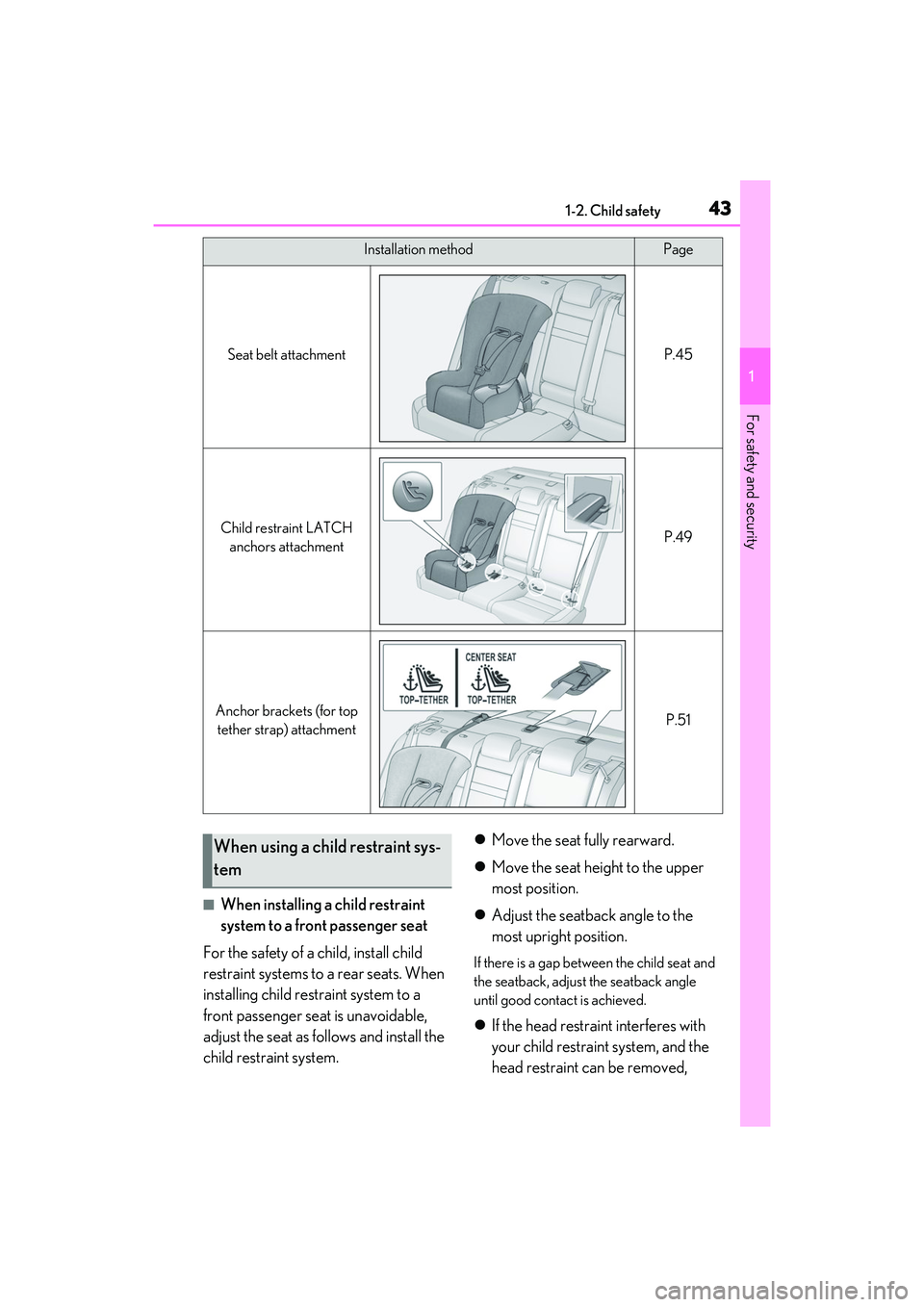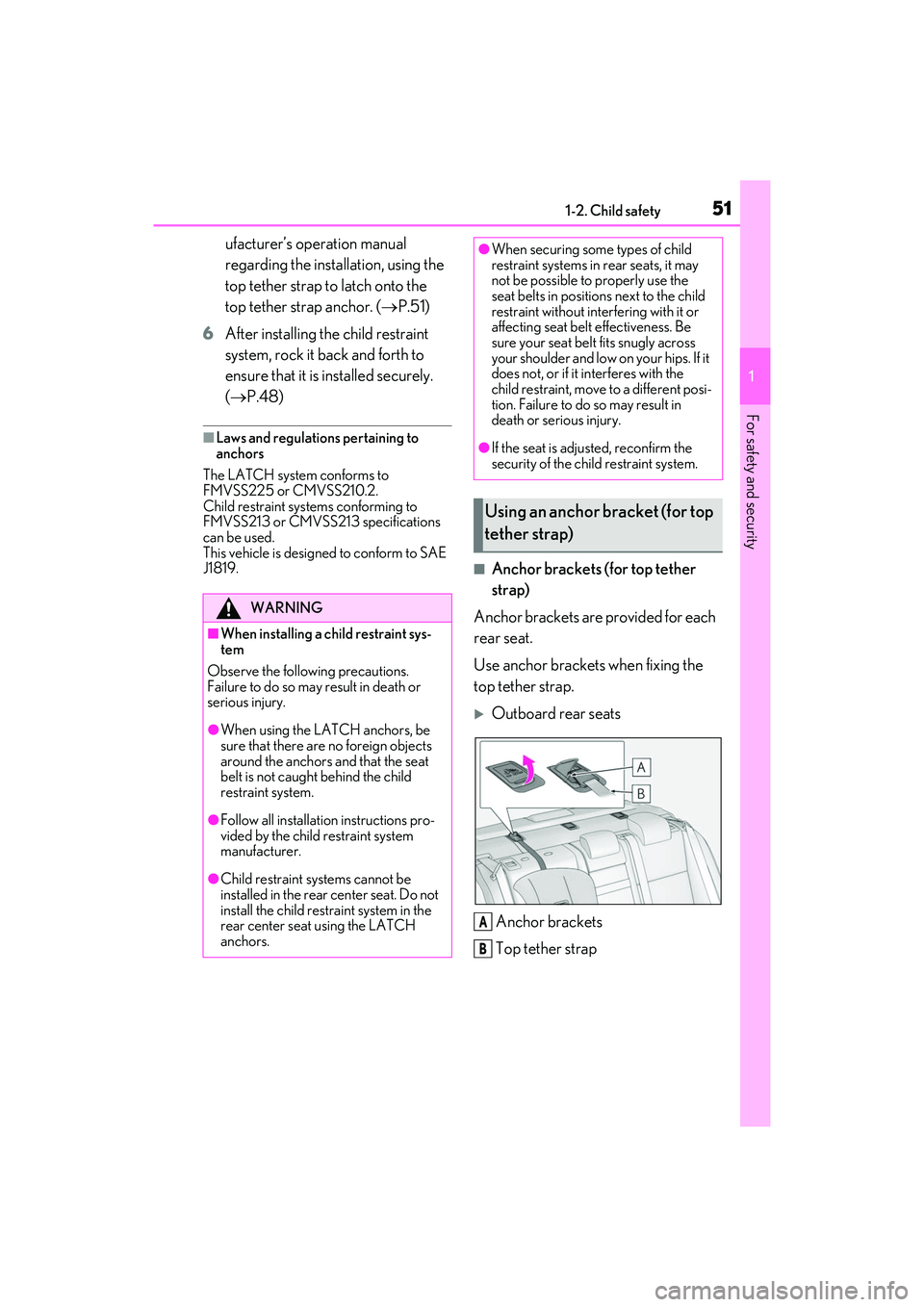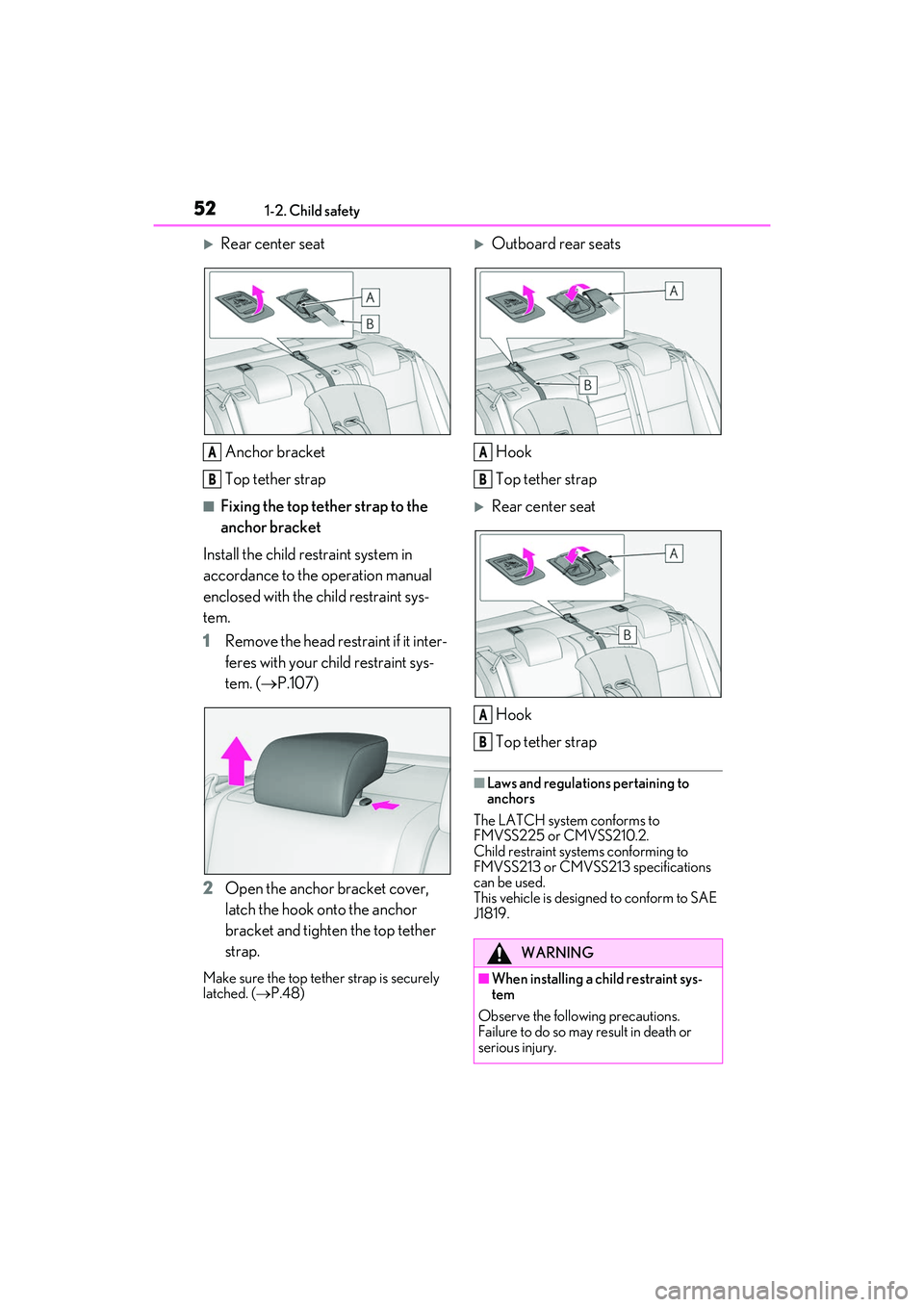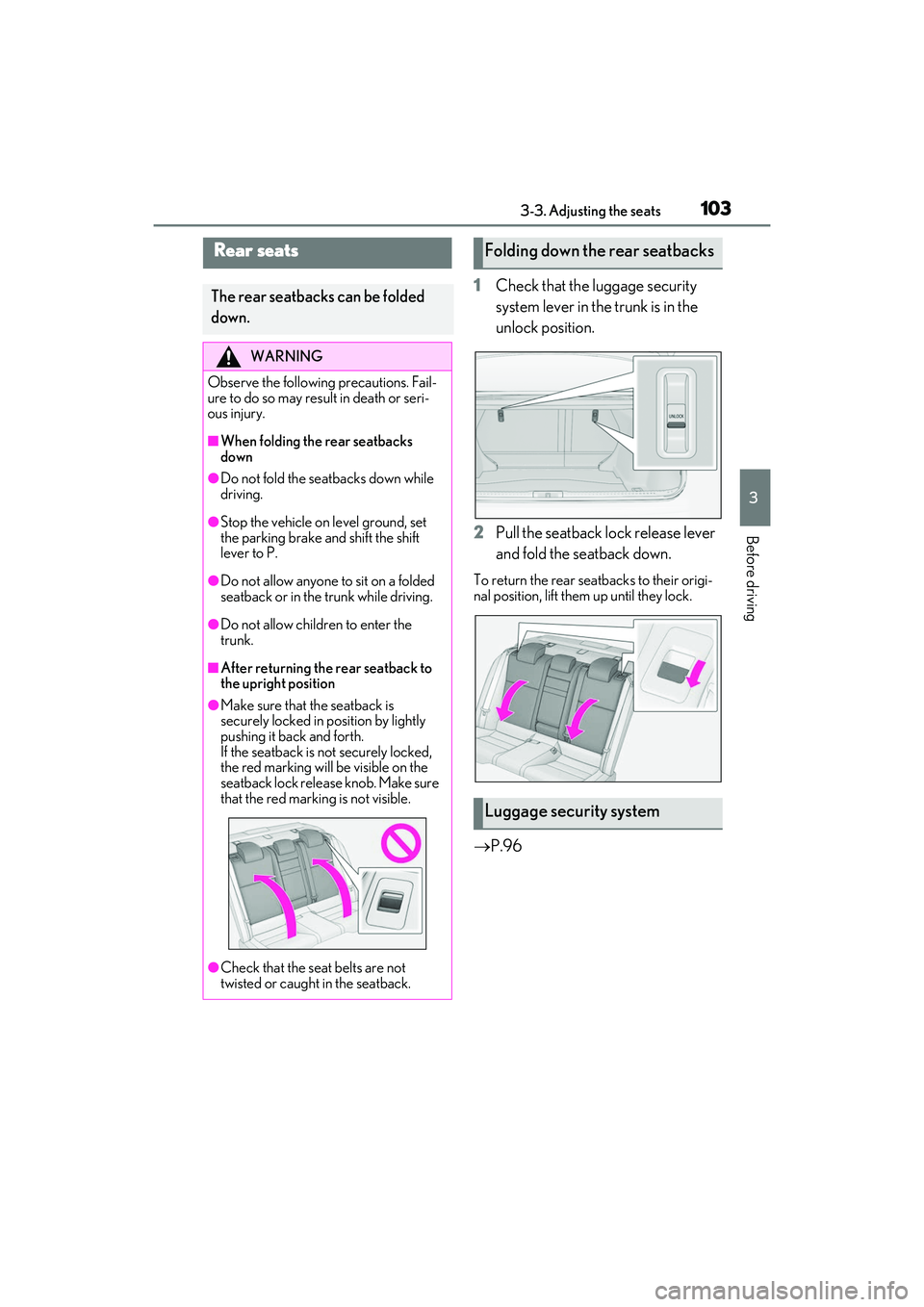2022 LEXUS IS300 seats
[x] Cancel search: seatsPage 45 of 440

431-2. Child safety
1
For safety and security
■When installing a child restraint
system to a front passenger seat
For the safety of a child, install child
restraint systems to a rear seats. When
installing child restraint system to a
front passenger seat is unavoidable,
adjust the seat as follows and install the
child restraint system.
Move the seat fully rearward.
Move the seat height to the upper
most position.
Adjust the seatback angle to the
most upright position.
If there is a gap between the child seat and
the seatback, adjust the seatback angle
until good contact is achieved.
If the head restraint interferes with
your child restraint system, and the
head restraint can be removed,
Installation methodPage
Seat belt attachmentP.45
Child restraint LATCH
anchors attachmentP.49
Anchor brackets (for top tether strap) attachmentP.51
When using a child restraint sys-
tem
Page 51 of 440

491-2. Child safety
1
For safety and security
■Child restraint LATCH anchors
LATCH anchors are provided for the
outboard rear seat. (Buttons displaying
the location of the anchors are
attached to the seats.)
■When installing in the rear out-
board seats
Install the child restraint system in
accordance to the operation manual
enclosed with the child restraint sys-
tem.
1 Adjust the seat
If there is a gap between the child seat and
the seatback, adjust the seatback angle
until good contact is achieved.
WARNING
●When a booster seat is installed,
always ensure that th e shoulder belt is
positioned across the center of the
child’s shoulder. T he belt should be
kept away from the child’s neck, but
not so that it could fall off the child’s
shoulder.
●Follow all installation instructions pro-
vided by the child restraint system
manufacturer.
●When securing some types of child
restraint systems in rear seats, it may
not be possible to properly use the
seat belts in position s next to the child
restraint without inte rfering with it or
affecting seat belt effectiveness. Be
sure your seat belt fits snugly across
your shoulder and low on your hips. If it
does not, or if it interferes with the
child restraint, move to a different posi-
tion. Failure to do so may result in
death or serious injury.
●When installing a child restraint system
in the rear center seat, adjust both seat
cushions to the same position and
align both seatbacks at the same
angle. Otherwise, the child restraint
system cannot be securely restrained
and this may cause death or serious
injuries in the event of sudden braking,
sudden swerving or an accident.
●If the seat is adju sted, reconfirm the
security of the child restraint system.
■When installing a booster seat
To prevent the belt from going into ALR
lock mode, do not fu lly extend the shoul-
der belt. ALR mode causes the belt to
tighten only. This could cause injury or
discomfort to the child. (
P.26)
■Do not use a seat belt extender
If a seat belt extender is used when
installing a child restra int system, the seat
belt will not securely hold the child
restraint system, which could cause
death or serious injury to the child or
other passengers in the event of sudden
braking, sudden swerving or an accident.
Child restraint system fixed with
a child restraint LATCH anchor
Page 53 of 440

511-2. Child safety
1
For safety and security
ufacturer’s operation manual
regarding the installation, using the
top tether strap to latch onto the
top tether strap anchor. (P.51)
6 After installing the child restraint
system, rock it back and forth to
ensure that it is installed securely.
( P.48)
■Laws and regulations pertaining to
anchors
The LATCH system conforms to
FMVSS225 or CMVSS210.2.
Child restraint systems conforming to
FMVSS213 or CMVSS213 specifications
can be used.
This vehicle is designed to conform to SAE
J1819.
■Anchor brackets (for top tether
strap)
Anchor brackets are provided for each
rear seat.
Use anchor brackets when fixing the
top tether strap.
Outboard rear seats
Anchor brackets
Top tether strap
WARNING
■When installing a child restraint sys-
tem
Observe the following precautions.
Failure to do so may result in death or
serious injury.
●When using the LATCH anchors, be
sure that there are no foreign objects
around the anchors and that the seat
belt is not caught behind the child
restraint system.
●Follow all installation instructions pro-
vided by the child restraint system
manufacturer.
●Child restraint systems cannot be
installed in the rear center seat. Do not
install the child restraint system in the
rear center seat using the LATCH
anchors.
●When securing some types of child
restraint systems in rear seats, it may
not be possible to properly use the
seat belts in position s next to the child
restraint without interfering with it or
affecting seat belt effectiveness. Be
sure your seat belt fits snugly across
your shoulder and low on your hips. If it
does not, or if it interferes with the
child restraint, move to a different posi-
tion. Failure to do so may result in
death or serious injury.
●If the seat is adjusted, reconfirm the
security of the child restraint system.
Using an anchor bracket (for top
tether strap)
A
B
Page 54 of 440

521-2. Child safety
Rear center seatAnchor bracket
Top tether strap
■Fixing the top tether strap to the
anchor bracket
Install the child restraint system in
accordance to the operation manual
enclosed with the child restraint sys-
tem.
1 Remove the head restraint if it inter-
feres with your child restraint sys-
tem. ( P.107)
2 Open the anchor bracket cover,
latch the hook onto the anchor
bracket and tighten the top tether
strap.
Make sure the top tether strap is securely
latched. ( P.48)
Outboard rear seats
Hook
Top tether strap
Rear center seat
Hook
Top tether strap
■Laws and regulations pertaining to
anchors
The LATCH system conforms to
FMVSS225 or CMVSS210.2.
Child restraint systems conforming to
FMVSS213 or CMVSS213 specifications
can be used.
This vehicle is designed to conform to SAE
J1819.
A
B
WARNING
■When installing a child restraint sys-
tem
Observe the following precautions.
Failure to do so may result in death or
serious injury.
A
B
A
B
Page 87 of 440

85
3
3
Before driving
Before driving
.3-1. Key informationKeys ................................................... 86
3-2. Opening, closing and locking the doors and trunk
Doors................................................. 90
Trunk.................................................. 94
Smart access system with push-button start ....................... 97
3-3. Adjusting the seats Front seats ..................................... 102
Rear seats ...................................... 103
Driving position memory ........ 104
Head restraints............................ 107
3-4. Adjusting the steering wheel and mirrors
Steering wheel............................. 109
Inside rear view mirror.............. 110
Outside rear view mirrors ....... 112
3-5. Opening, closing the windows and moon roof
Power windows............................ 114
Moon roof ...................................... 116
Page 94 of 440

923-2. Opening, closing and locking the doors and trunk
■Rear seat reminder function
In order to remind you not to forget lug-
gage, etc. in the rear seat, when the engine
switch is turned off after any of the following
conditions are met, a buzzer will sound and
a message will be displayed on the
multi-information display for approximately
6 seconds.
●The engine is started within 10 minutes
after opening and closing a rear door.
●A rear door has been opened and closed
after the engine was started.
However, if a rear door is opened and then
closed within approxim ately 2 seconds, the
rear seat reminder function may not oper-
ate.
The rear seat reminder function determines
that luggage, etc. has been placed in a rear
seat based on opening and closing of a rear
door. Therefore, depend ing on the situation,
the rear seat reminder function may not
operate and you may still forget luggage,
etc. in the rear seat, or it may operate
unnecessarily.
The rear seat reminder function can be
enabled/disabled.
■Customization
Some functions can be customized.
( P.388)
■Door lock switches
1 Locks all the doors
2 Unlocks all the doors
■Inside lock buttons
1 Locks the door
2 Unlocks the door
The front doors can be opened by pull-
ing the inside handle even if the lock
buttons are in the lock position.
■Locking the doors from the outside with-
out a key
1 Move the inside lock button to the lock
position.
2 Close the door.
The door cannot be lo cked if the engine
WARNING
■To prevent an accident
Observe the following precautions while
driving the vehicle.
Failure to do so may result in a door
opening and an occupant being thrown
out of the vehicle, resulting in death or
serious injury.
●Ensure that all doors are properly
closed and locked.
●Do not pull the inside handle of the
doors while driving.
Be especially careful with the front doors,
as the doors may be opened even if the
inside lock buttons are in locked position.
●Set the rear door ch ild-protector locks
when children are seated in the rear
seats.
Unlocking and locking the doors
from the inside
Page 104 of 440

1023-3. Adjusting the seats
3-3.Adjusting the seats
Seat position adjustment
Seatback angle adjustment
Seat cushion (front) angle adjust-
ment
Seat cushion (rear) angle adjust-
ment
Lumbar support adjustment (if
equipped)
■Power easy access system (if equipped)
The driver’s seat and steering wheel move
in accordance with engine switch mode and
the driver’s seat belt condition. ( P.104)
■When adjusting the seat
●Take care when adjusting the seat so that
the head restraint does not touch the ceil-
ing.
●When folding down a rear seatback, if it
interferes with a front seatback, adjust the
front seat position so that the seats no
longer interfere with each other. How-
ever, if adjusting the front seat position
causes the correct driving posture to not
be maintained, return the rear seatback
to its original position. ( P.103)
Front seats
WARNING
■When adjusting the seat position
●Take care when adjusting the seat
position to ensure that other passen-
gers are not injured by the moving
seat.
●Do not put your hands under the seat
or near the moving parts to avoid
injury.
Fingers or hands may become
jammed in the se at mechanism.
●Make sure to leave enough space
around the feet so they do not get
stuck.
■Seat adjustment
To reduce the risk of sliding under the lap
belt during a collision, do not recline the
seat more than necessary.
If the seat is too reclined, the lap belt may
slide past the hips and apply restraint
forces directly to the abdomen, or your
neck may contact the shoulder belt,
increasing the risk of death or serious
injury in the event of an accident.
Adjustments should not be made while
driving as the seat may unexpectedly
move and cause the driver to lose control
of the vehicle.
Adjustment procedure
A
B
C
D
E
Page 105 of 440

1033-3. Adjusting the seats
3
Before driving
1Check that the luggage security
system lever in the trunk is in the
unlock position.
2 Pull the seatback lock release lever
and fold the seatback down.
To return the rear seatbacks to their origi-
nal position, lift them up until they lock.
P.96
Rear seats
The rear seatbacks can be folded
down.
WARNING
Observe the following precautions. Fail-
ure to do so may result in death or seri-
ous injury.
■When folding the rear seatbacks
down
●Do not fold the seatbacks down while
driving.
●Stop the vehicle on level ground, set
the parking brake and shift the shift
lever to P.
●Do not allow anyone to sit on a folded
seatback or in the trunk while driving.
●Do not allow children to enter the
trunk.
■After returning the rear seatback to
the upright position
●Make sure that the seatback is
securely locked in position by lightly
pushing it back and forth.
If the seatback is not securely locked,
the red marking will be visible on the
seatback lock release knob. Make sure
that the red marking is not visible.
●Check that the seat belts are not
twisted or caught in the seatback.
Folding down the rear seatbacks
Luggage security system